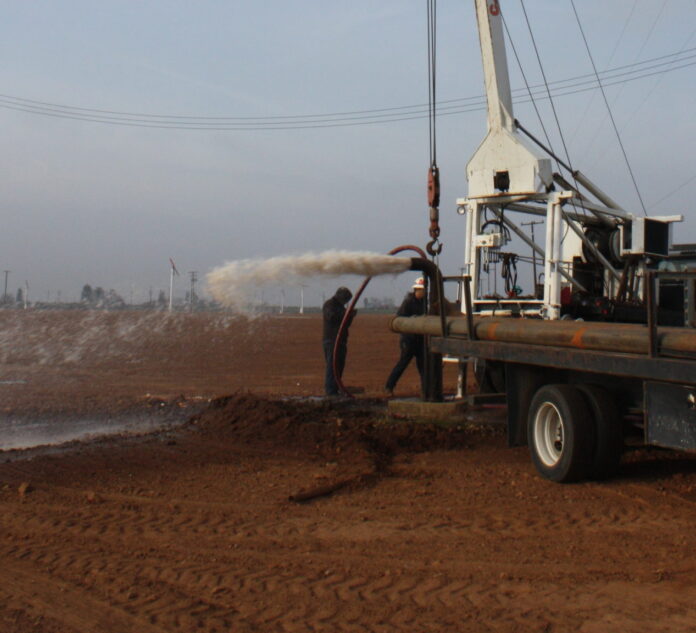 The Tulare Irrigation District held its board of directors meeting on Tuesday, July 14, 2020 remotely from its Tulare headquarters. TID has been pretty innovative over the years. It was one of the first to use a magnetic towed array sensor dangling from a helicopter to get geological information to help in determining its groundwater assets. Other parts of the Valley are now looking into doing the same. The meeting kicked off about 9am with Chairman David Bixler calling it to order. Director Scott Rogers wasn’t in the picture and I don’t know if he was on call or not. Mr. Rogers is taciturn man by nature.
The Tulare Irrigation District held its board of directors meeting on Tuesday, July 14, 2020 remotely from its Tulare headquarters. TID has been pretty innovative over the years. It was one of the first to use a magnetic towed array sensor dangling from a helicopter to get geological information to help in determining its groundwater assets. Other parts of the Valley are now looking into doing the same. The meeting kicked off about 9am with Chairman David Bixler calling it to order. Director Scott Rogers wasn’t in the picture and I don’t know if he was on call or not. Mr. Rogers is taciturn man by nature.
I must confess – I got caught on a call and joined a bit late and missed the approval of the minutes and explanation of remote meeting etiquette. Superintendent Wayne Fox gave his report saying the spraying for weed control was taken care off early due to the hard  work of the district’s crews. He said it is paying off now that the season has started. There was some cooperation on the project with the Kaweah Delta Water Conservation District. Kaweah Delta shared yard space for supplies and equipment. Fox said now there is only two workers having to spray for weed control which frees up others to start prepping for winter maintenance projects. Sounds like the crew got everything off to a head start this year.
work of the district’s crews. He said it is paying off now that the season has started. There was some cooperation on the project with the Kaweah Delta Water Conservation District. Kaweah Delta shared yard space for supplies and equipment. Fox said now there is only two workers having to spray for weed control which frees up others to start prepping for winter maintenance projects. Sounds like the crew got everything off to a head start this year.
Controller Kathi Artis gave her report and everything was in good shape. She keeps good books and records and applies them properly. I’d be willing to be some of the most fiscally responsible branches of government, certainly in California if not the entire nation, are irrigation and water districts. There was a pause as the expenditures were being reviewed and I think it was Director Rick Borges who asked if peoples’ temperatures were being taken before entering the office. I just heard yesterday by the time you have a temperature from the Chinese Communist virus you’ve already been spreading it for a couple of days. But who knows? As we are all aware it’s been a crazy year. The nation battles a pandemic and the totalitarians take advantage of it. Anyway, General Manager Aaron Fukuda explained the district has been making purchases with a credit card and earning cash while doing so. I think he said there’s an extra $1,500 for the office Christmas party.
Next Fukuda presented the board with a plan to refinance a loan to get lower interest rates and save some good dough. Doug Brown, bound counsel with Stradling, Yocca, Carlson & Rauth was present to advise and educate. Also by phone Robert Porr with Fieldman, Rolapp & Associates is a municipal bond advisor. TID has a loan with Bank of America and if B of A were willing to do so the easiest way to fix things is refinance with B of A. Another method would be to seek bids for refinance or as Fukuda said the most aggressive option would be public issuance bonds.
Brown spoke about private placement with lenders. He and his firm have helped several districts in the Valley go through this refinancing process. He was aware of the problems on the Friant Kern Canal having an impact on TID’s debt service. He said it can be structured so TID’s obligations are paid first. The district would still have a duty to pay on the FKC but protected for its own debt.
Porr spoke next saying his firm has also done work with districts in the Valley. He concurred with Brown a private placement is quicker, less expensive and since the deal is relatively small (I didn’t catch the amount but I think it was less than $10 million – relatively small) TID could conceivably get a better rate. The banks would be solicited to offer terms and those terms could be negotiated with the most favorable one being selected. The district could save about $457,000 over the lifetime. If I understood correctly this could change  depending on interest rates. There is a job with the title of “placement agent.” These guys are the ones who actually solicit the banks and gather offers, they have the connections evidently. There were discussions about how to structure things so the Prop 218 income can remain the same but get the loan paid off sooner. Porr said the WIIN Act allowed for contract conversions and many districts in the Sacramento Valley and the San Joaquin Valley’s westside are looking at 218 elections to fund the conversions and debt refinance.
depending on interest rates. There is a job with the title of “placement agent.” These guys are the ones who actually solicit the banks and gather offers, they have the connections evidently. There were discussions about how to structure things so the Prop 218 income can remain the same but get the loan paid off sooner. Porr said the WIIN Act allowed for contract conversions and many districts in the Sacramento Valley and the San Joaquin Valley’s westside are looking at 218 elections to fund the conversions and debt refinance.
Fukuda told the board he’d like Brown and Porr’s help in putting this deal together and getting it on the district’s strategic plan. He said the first step is refinancing this loan. Brown or Porr, don’t know which one, said their billing comes at closing time and the board will be well aware of the costs well before that takes place. So, Fukuda wasn’t looking for approval rather direction. The board directed he do so.
Next the board got an assessment update. The problem I was having during this meeting was the documents that appeared on screen were so small I couldn’t read them. Then some how or other buttons to make them bigger or smaller magically showed up. In TID land in access of five acres or more. The notices were mailed on July 1st and they are due by the 27th. Tax liens won’t kick in until August 24th. Fukuda remarked with the Chinese  Communist virus and a dry year the response was greater than expected. Especially the smaller payments. Good for them. There are more than 2,000 parcels in the district. Some big health care provider is putting in a health care center and hasn’t paid. TID also has the not such a bad problem of folks paying too much.
Communist virus and a dry year the response was greater than expected. Especially the smaller payments. Good for them. There are more than 2,000 parcels in the district. Some big health care provider is putting in a health care center and hasn’t paid. TID also has the not such a bad problem of folks paying too much.
There was no engineering report from Jeremy Barroll this month but Fukuda said the district has had problems with the telephone and internet. Barroll did the majority of the work in researching and finding solutions. The district pays $720 a month to AT&T for 11 lines but three or four work at anyone time. Novastorm Wireless charges $75 a month for broadband but there have been so many problems the district hasn’t been charged. The system they have is unreliable and AT&T has flat out told them it won’t be investing in landlines anymore. Fukuda said it is incredibly frustrating to loss the phones during assessment season. The situation is getting so bad the SCADA system and even the headquarter security could be jeopardized. Fukuda said Comcast and Verizon could fulfill the need for $1,020 for 50megs of data and voice over IP. I’m not going to say which director but one suggested opening a weekly drive-in to recoup the costs. They all understood moving the communication system forward is necessary. Remote meetings are not only the future, they are the present. Barroll was on the phone and he was asked about the contract terms. He said Verizon contracts will go on but questions to Sebastian Communications went unanswered. He said it was a bit of a red flag. Verizon or Comcast will also integrate the security system.
Staff reports were next and Fukuda said he’s developing an action plan in case the Chinese Communist virus strikes and putting it on paper. So far there have been two potential exposures that took folks out but no health matters.
The Mid-Kaweah Sub Basin is using GEI for its consultant. Fukuda said he’s been enjoying the Sky Tem team (the helicopter towed array) have been very productive. Stanford University is involved in paying for the service. The missing well data is being augmented by a micro camera. The pump doesn’t have to be pulled and that saves thousands of dollars per well. Fukuda said not only the cheaper costs but since this is Provost & Pritchard providing the service they are also taking the risk of dropping the thing down the hole. Water levels and screen depths are being looked at. There is a proposal for the GSA to help pay a portion of the costs when someone pulls a well if they can video it.
Fukuda said the MKGSA has a bunch of moving pieces and there need to be priorities set. He said there were eight comment letters on the GSP and Fukuda said some of the comments are reasonable and constructive. But some were so out there the authors will never be placated. The Animal Legal Defense Fund is trying to use SGMA to get shed of dairies and feed lots. Dairy Cares sent out letters in response to the ALDF letters. Word is the lawyer who wrote the comment for the ALDF charged too much.* However, only the Mid Kaweah and the Greater Kaweah GSAs received these letters so there could be a legal fight brewing. There is no mandate the GSAs provide feedback but some of the comments need to be addressed. One comment was the MIKGSA didn’t provide Spanish translations which was absolutely false. There were other comments from people who never once  attended a meeting. SGMA was set up for the locals to determine what is needed and if these folks never bothered to show up they forfeited their voice. There were also form letters send out, I believe California Fish & Wildlife did so. Same letter to everyone. Wouldn’t it be cool if somehow government agencies commenting on government agencies got caught in an for/next loop of continue comments and response? They could then leave the rest of us alone and I suspect waste less taxpayer dollars. Fukuda and the board were sad to learn Ed Henry will be leaving the MKGSA advisory committee.
attended a meeting. SGMA was set up for the locals to determine what is needed and if these folks never bothered to show up they forfeited their voice. There were also form letters send out, I believe California Fish & Wildlife did so. Same letter to everyone. Wouldn’t it be cool if somehow government agencies commenting on government agencies got caught in an for/next loop of continue comments and response? They could then leave the rest of us alone and I suspect waste less taxpayer dollars. Fukuda and the board were sad to learn Ed Henry will be leaving the MKGSA advisory committee.
Fukuda then reported on the Friant matters. He said the Friant Water Authority staff has been miraculous in keeping the Friant Kern Canal repair project moving along so well. He credited CEO Jason Phillips as bringing a good deal of clout to the proceedings as he has  respectful ties with the US Bureau of Reclamation. He also said self-funding from Arvin Edison WSD an, Renewable Resource Group and Sun World providing money to the Eastern Tule GSA is coming in nicely. Fukuda said there some things to be cautious over. A mitigation for ETGSA transitional pumping can’t apply to any Zone Three capacity. He wouldn’t go into details. Borges represents TID at Friant and he said the Airborne Snow Observatory flights funding is changing somewhat.
respectful ties with the US Bureau of Reclamation. He also said self-funding from Arvin Edison WSD an, Renewable Resource Group and Sun World providing money to the Eastern Tule GSA is coming in nicely. Fukuda said there some things to be cautious over. A mitigation for ETGSA transitional pumping can’t apply to any Zone Three capacity. He wouldn’t go into details. Borges represents TID at Friant and he said the Airborne Snow Observatory flights funding is changing somewhat.
Legislation was next and Fukuda said the infrastructure bills are moving forward. He’s talking with a firm from Southern California that claims it might be able to get TID infrastructure in funding bills. We’ll see.
The McKay Point project has to meet with local Indian tribes so to fulfill the cultural justice or environment or something requirement. Director Dave Martin asked if Cemex wasn’t having a problem in Fresno County with sand mining. They want to blast mine on the San Joaquin River bottom below a high end residential area on the bluffs above.
The board and Fukuda talked about the presentation given earlier by Brown and Porr. They made a good impression and seem to know what the district needs. Fukuda said they can put the information into a spread sheet that shows how expenses and revenue can impacted by different strategies. He found that very helpful.
Fukuda said the contract with Brown is for bond counsel and Porr is about $45,000 for their help. That doesn’t include the fees for the placement agents. They are the middlemen in this case. He said interest rates are falling and it is possible B of A is willing to play and there won’t be further costs. He said he’s spoken with Lindsay Strathmore ID, Fresno ID and other local districts that have used these gentlemen and they have all spoken highly of them. The board approved hiring the team. The board also passed Resolution 20-08 to place delinquent assessments on the county tax roll. That was routine.
Fukuda said the company with the helicopter towed array had some difficulties in Denmark but things are back in shape. He said Stanford University and TID can share some of the costs for the trailer towed, land based magnetic array. Stanford’s attorneys got panty bunched over the agreement but it was worked out. If someone else were to use it Barroll would go with it to chaperone. And operate it since no one else knows how. Stanford wanted a quad to tow it but you’ll get your face spanked with branches going through an orchard. The board approved purchasing a suitable vehicle with a windshield. The Kaweah Sub Basin needs to work with the Bureau on a basin water marketing strategy and TID will have to pay for part of this cost. But it is expected transactions will ultimately pay for the costs from fees. The details aren’t fixed yet. This is for groundwater marketing. The board passed the motion. Finally the board considered the Consumer Price Index for adjusting the water and salary costs. I believe the increase has been about a half a percent. The board went along with it and gave everyone a raise. Good for them.
The meeting then took a break and will go into closed session. *You know, and I’m serious about this, if you want to partner with me on forming a 501C3 called Animal Voting Rights get in touch. I think we could make a killing.
DISCLAIMER OF RESPONSIBILITY; Waterwrights strives to provide his clients with the most complete, up-to-date, and accurate information available. Nevertheless, Waterwrights does not serve as a guarantor of the accuracy or completeness of the information provided, and specifically disclaims any and all responsibility for information that is not accurate, up-to-date, or complete. Waterwrights’ clients therefore rely on the accuracy, completeness and timeliness of information from Waterwrights entirely at their own risk. The opinions expressed in this report are those of the author and do not represent any advertisers or third parties.
ALL RIGHTS RESERVED. Copyright 2020 by WaterWrights.net/DAW
TULARE IRRIGATION DISTRICT
6826 Ave 240, Tulare, CA 93274 Office: 559/686-3425
Board: David G. Bixler- President, Richard S. Borges, Jr.-Vice President, Scott Rogers, Dave Martin & Michael Thomas
Staff: Aaron Fukuda-General Manager, Jeremy Barroll-Engineer, Kathi Artis–District Controller, Wayne Fox–Superintendent, Marco Crenshaw–District Watermaster & Alex Peltzer-Attorney.
About: The Tulare Irrigation District was organized September 21, 1889. The original proposal for the formation of an irrigation district covering 219,000 acres, extending from the Sierra Nevada foothills to Tulare Lake, was eventually reduced to 32,500 acres. The District continued in this status until January of 1948 when the so-called Kaweah Lands” (approximately 11,000 acres) were annexed. In October of 1948, approximately 31,000 acres, compromising the area served by the Packwood Canal Company were annexed to the District. A U.S. Bureau of Reclamation contract was signed in 1950 providing an annual supply of 30,000 acre-feet of Class 1 water, and up to 141,000 acre-feet of Class 2 water from the Friant-Kern Canal. The District and the Kaweah Delta Water Conservation District have coordinated efforts to enhance the recharge of groundwater within the Kaweah Basin. During high flow times KDWCD may use the recharge basins with the District for recharge purposes. Further, KDWCD has historically provided for a financial incentive program through which the District sustains the level of groundwater recharge from supply sources into the District. This historical program was recently reinstated by both districts in lieu of the District’s plans to concrete-line this canal to conserve the surface water. TID is a member of the Mid Kaweah GSA.





























